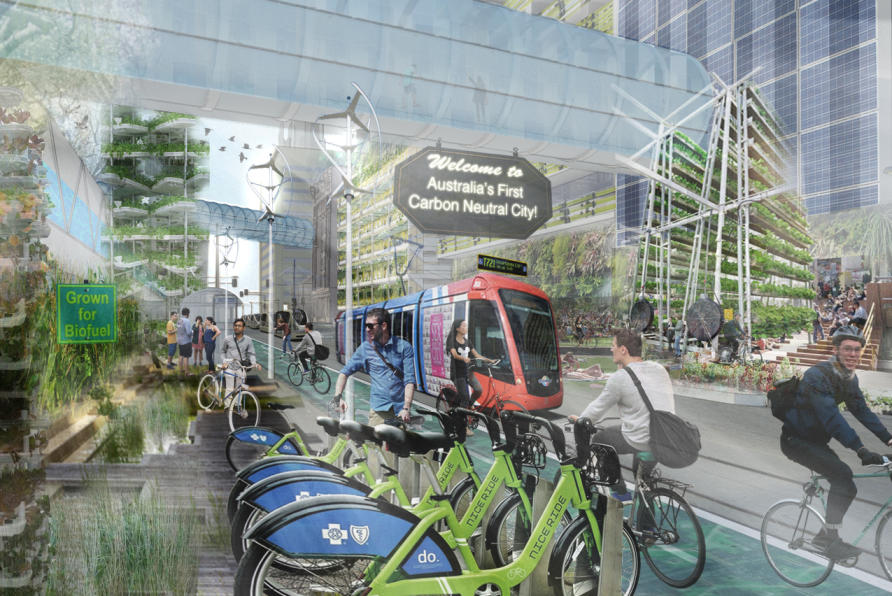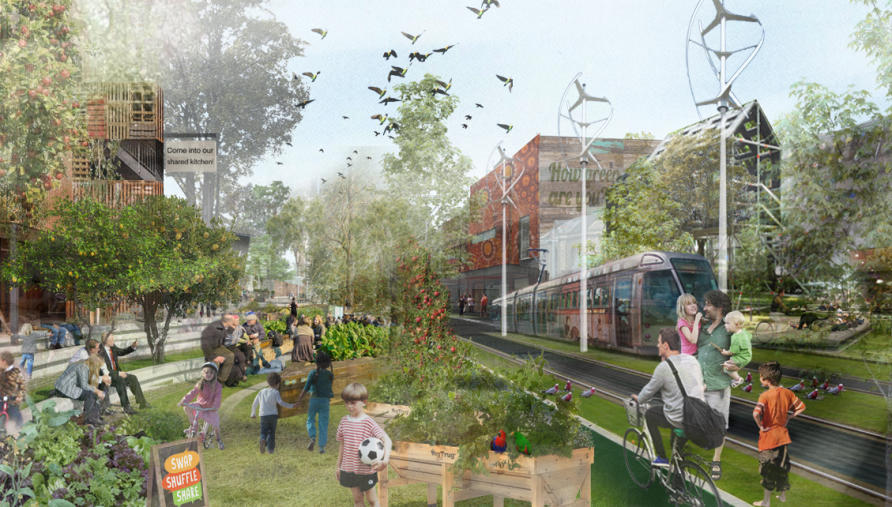What could sustainable Australian cities look like in 2040?

It’s 2040.
As you wake and look outside, things might not look hugely different to 2017 – there aren’t any hoverboards or sky highways – but Australian cities have managed to cut their greenhouse gas emissions by 80 per cent.
And how your day unfolds will look very different depending on how we reached this point.
As you step outside some changes are obvious. Renewable energy is now everywhere. You pass bladeless wind turbines, and solar farms on city skyscapers. On your way, you walk through an urban farm and the concrete jungle is greener with roof and vertical gardens throughout the city. But you’ve had to make some concessions in terms of privacy and lifestyle.
So what’s changed? And how did we get here?
These are just some of the questions explored in the final report from the Visions and Pathways 2040 research project which looks at how we can rapidly reduce Australian cities’ emissions to avoid catastrophic climate change as we approach the end of what’s being called the ‘critical decade’.
We’re going the wrong way
The report finds that exactly how we achieve emissions reductions will have a profound impact on what life in Australia is like in the future. Many of the technologies required to get us to a greener future already exist - but what’s important is how we apply them and who drives the change.
Over the last four years, through research, workshops and engagement activities, the project has drawn on input from over 250 experts across industry, government, academia and civil society to determine how Australian cities could reach this goal. But also to design what these future cities might look like.
This group of experts came together because they can see Australia is not on track to achieve even its stated emissions reductions targets. These targets have been put in place by successive governments who have repeatedly weakened the numbers and the criteria – and still we cannot meet them.
Since the removal of the carbon price, Australia’s emissions have started to increase again. We are going the wrong way.
The Australian political context means the multitude of technical pathways are clear, but the cultural, political and economic pathways are not. The Action Pathways in our report consider the forces of change that might be required to achieve the drastic greenhouse gas emissions reductions we seek.
But how do we trigger political changes of this magnitude, and what is our own potential power in progressing these?

Two pathways
The team designed two scenarios to demonstrate these positive outcomes - ‘Green Growth’ and a ‘Commons Transition’.
The first Green Growth scenario points to the role city governments, driven by community and stakeholder action, can play in discouraging organisations and businesses that are not explicitly and proactively decarbonising. This social and political mobilisation could help drive out the complicit acceptance and corruption preventing rapid reduction in fossil fuel use and development.
The Commons Transition scenario paints a new picture that re-empowers the citizen movement already evident in sweeping social changes in cities around the world. It draws on leading innovations in sharing and shareable cities; peer-to-peer, Open Design Distributed Manufacturing, cooperatives and platform cooperative movements, as well as some new, more radical cultural, political and economic initiatives.
These new movements are already gaining momentum. Citizen groups in countries like Spain, Iceland, Taiwan, Korea and Italy have not just challenged power, but also forged new political contracts that place citizens at the centre of city decision-making.
To ensure future cities achieve the necessary emissions reductions, we modelled them using the CSIRO-developed Australian Stocks and Flows Framework, which factors in not just for cities as they stand in 2040, but also the pathway that might get us there.
Consuming and emitting
We took a consumption-based approach including both direct and indirect emissions. Direct emissions, like your car’s exhaust or burning gas to heat your house, occur within city boundaries. Indirect or embodied emissions are associated with the production of goods and services that support our urban lifestyles but are usually generated outside the city, like food, household appliances and electricity.
According to our research, direct emissions make up around 16 per cent of overall city emissions, equivalent to 52 million tonnes of carbon dioxide in 2013.
Changes to urban lifestyles like more active transport, reducing landfill waste, switching to electric transport coupled with clean electricity generation, as well as improving the design of our buildings, results in a reduction of these direct emissions of around 60 per cent by 2040 for both pathways.
The results indicate, though, that the majority of emissions related to a city lifestyle are produced outside city boundaries. Electricity generation contributes almost 50 per cent of the carbon footprint of southern Australian cities, with heavy industry and agriculture contributing around 12 per cent and 9 per cent respectively.
To significantly reduce city emissions, our report shows the accelerated replacement of fossil fuel power stations with 100 per cent clean generation technologies must be a priority. There’s also an urgent need to reduce heavy industry and agricultural production through recycling, lowering consumption of red meat and reducing exports, which account for the majority of indirect emissions in these sectors.

To achieve overall emissions reductions of 80 per cent by 2040 and in the critical short term, we also need to switch from forest clearing to forest preservation and regeneration, and rapidly increase other land uses that can sequester carbon (capturing and storing atmospheric carbon dioxide) like agricultural production systems and urban forestry.
Imagining a greener future
Emissions reductions of this scale can be achieved, but will require – and drive – massive transformation of our cities and even our societies, economies and politics.
Importantly, the report emphasises the important role of cities as cultural and political leaders – understanding, supporting and demanding change in production sectors and land-use outside the cities – as well as making the changes needed themselves.
The need for early and radical changes to land-use and management for carbon sequestration to ‘buy time’ for structural change, points to a critical role city dwellers can play as consumers of forestry, agricultural and food products, as well as directly in urban forestry.
To believe that these scenarios and action pathways are possible, any of them – let alone the ones we actually want – requires a leap of imagination. To make them possible requires a corresponding leap of determination.
The Visions and Pathways 2040 project challenges all of us - leaders and citizens alike - to be determined and prioritise reducing emissions before it’s too late, and points to the pathways that might just be able to get us there.
The project was led by the Victorian Eco-Innovation Lab at the University of Melbourne, and included researchers from Swinburne University and University of New South Wales. It was funded by the Australian Cooperative Research Centre for Low Carbon Living. Download the report from the Visions and Pathways 2040 website.

Originally published here.
Fluoride boosts water-processed perovskite solar cells
Queensland University of Technology has developed a water processing method to fabricate more...
Multibuild solar installation delivered at City of Playford
Trinasolar partnered with Venergy Solar to deliver a multibuild solar installation across the...
Oracle assists major distributor in clean energy transition
Essential Energy, an electricity distributor in Australia, is said to have modernised its...










